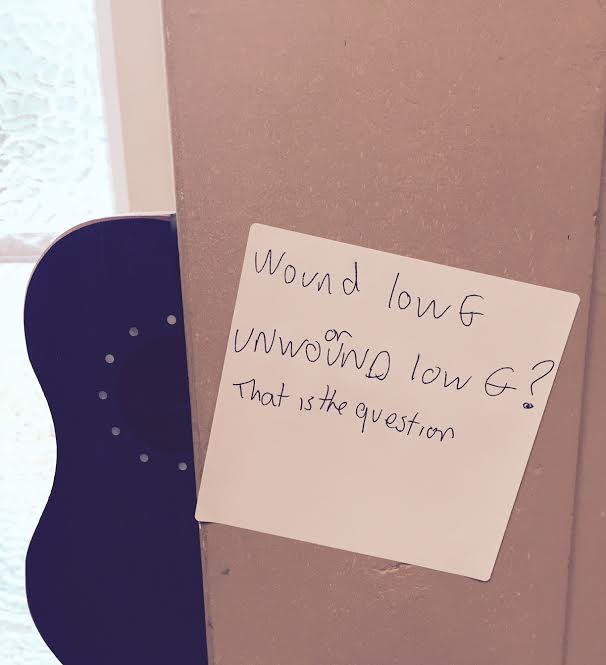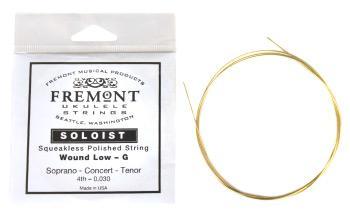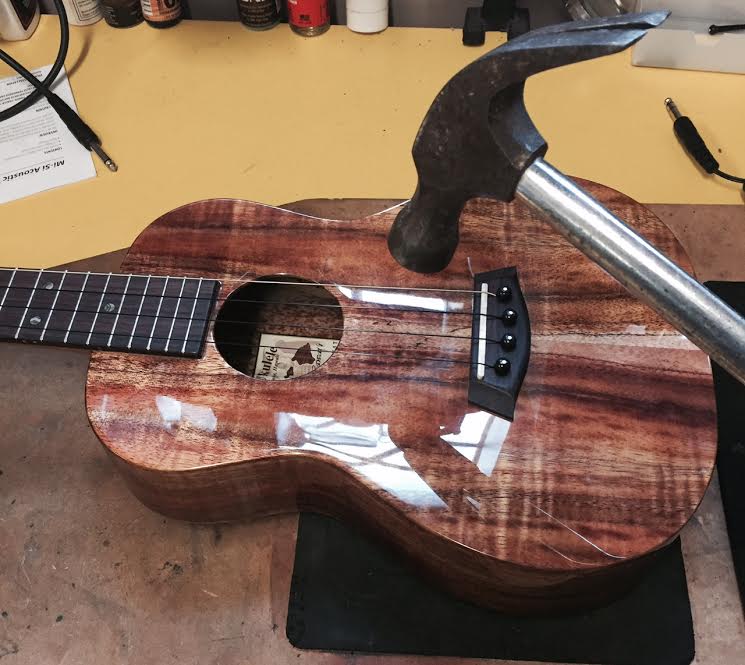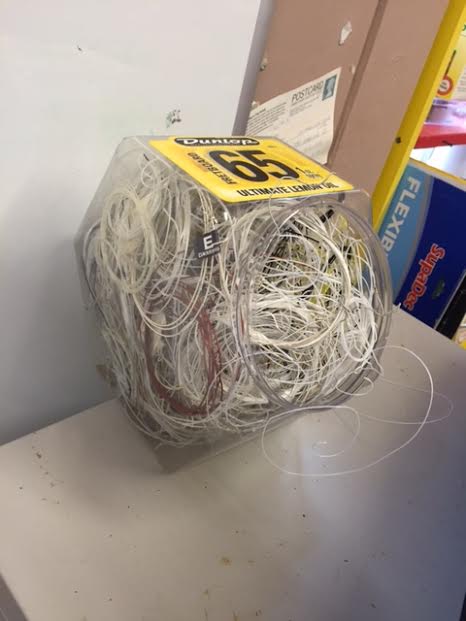We use cookies to make your experience better. To comply with the new e-Privacy directive, we need to ask for your consent to set the cookies. Learn more
Wound Low G or Unwound Low G? That is the question...
Wound Low G or Unwound Low G - That is the question?
Good day to you, as I write this it is Wednesday morning and I have already answered the eponymous question 4 times by email this week. It is not unusual for me to speak to customers about this every day and recently I even wrote this question on a post it note (pictured below) above my desk so that customers visiting the office might be impressed when I point to the wall foreshadowing part of our next conversation.
 Both have their benefits for sure but the difference between the Ukulele and other instruments is the amount of choice we have available to us. We write our own rules about how the Ukulele should sound and even manufacturers seem divided in which ukulele string is more suitable for the job. An unwound Worth low G comes as standard on a KoAloha, a wound Fremont squeakless string comes with a Blackbird Clara - Many luthiers use classical guitar strings for the same job. What is the right answer for me? I hear you ask. Hopefully this blog will help.
Wound Low G - Benefits
I think the benefits of a wound Low G far outweigh the negatives. A good wound low G offers a warmer, darker and more coloured sound. The most common Low G's by companies like Aquila, D'addario and Guadalupe use a silver winding and this gives them a distinct 'classical guitar' vibe. Classical Guitars are expressive, dynamic and usually very bright and this string reflects that.
Currently the most popular Low G string we stock is made by Fremont and is advertised as the 'Fremont Soloist Squeakless Polished String'. I have searched high and low to figure out the material it is made of but have to hazard a guess that it is a composite similar to brass, it certainly feels like polished brass. What makes this string so popular? It offers a unique mellow sound that sits somewhere between the bright silver wound low G's and the mellow unwound strings. I currently use this string on a Kanile'a tenor and it sits perfectly with flurocarbon strings and doesn't get overpowered by something bright like Aquila. If you use a Low G and haven't tried one of these yet then you are missing the boat on a safe bet and something innovative.
Both have their benefits for sure but the difference between the Ukulele and other instruments is the amount of choice we have available to us. We write our own rules about how the Ukulele should sound and even manufacturers seem divided in which ukulele string is more suitable for the job. An unwound Worth low G comes as standard on a KoAloha, a wound Fremont squeakless string comes with a Blackbird Clara - Many luthiers use classical guitar strings for the same job. What is the right answer for me? I hear you ask. Hopefully this blog will help.
Wound Low G - Benefits
I think the benefits of a wound Low G far outweigh the negatives. A good wound low G offers a warmer, darker and more coloured sound. The most common Low G's by companies like Aquila, D'addario and Guadalupe use a silver winding and this gives them a distinct 'classical guitar' vibe. Classical Guitars are expressive, dynamic and usually very bright and this string reflects that.
Currently the most popular Low G string we stock is made by Fremont and is advertised as the 'Fremont Soloist Squeakless Polished String'. I have searched high and low to figure out the material it is made of but have to hazard a guess that it is a composite similar to brass, it certainly feels like polished brass. What makes this string so popular? It offers a unique mellow sound that sits somewhere between the bright silver wound low G's and the mellow unwound strings. I currently use this string on a Kanile'a tenor and it sits perfectly with flurocarbon strings and doesn't get overpowered by something bright like Aquila. If you use a Low G and haven't tried one of these yet then you are missing the boat on a safe bet and something innovative.
 The least common but viable Low G strings are Bronze wound. The first time I saw a bronze wound Low G was on Joe Souza's Kanile'a six string and it's most common use in the Ukulele world is as the standard string on a Guitalele. Bronze is mellow, resistant to hard playing and looks cool because it doesn't stand out like a light coloured wound string. I often use this string on my Tenor and have on Concerts in the past if you are at all interested?
Wound Low G - Negatives
The most common complaint about a wound string is the feel. A wound string feels less spongy to the touch and players still developing their own technique or with a more delicate touch rarely fall in love with them.
Sometimes a wound string just doesn't compliment the player and can either sound very boomy or depending on the instrument you can get a slightly oversaturated series of overtones and unnatural harmonics when playing certain frequencies.
Cosmetically, a wound string can divide players too. I love the look of a wound string but some people think it looks wrong and I guess that is as good a reason as any not to go for one.
Unwound Low G - Positives
In the interest of fairness I suppose I should say that fitting an unwound Low G also has more benefits than negatives but in my experience this isn't the case. I know of two unwound Low G materials that work when tuned up to tension;
Flurocarbon such as Worth, Fremont or D'addario Carbon strings are the most fruitful option because the material is resistant to wear and tear and can offer an unobtrusive, mellow and introverted sound.
The Flurocarbon string fits quite harmoniously into a standard set of strings as well and as long as you don’t thump the strings and the instrument is well set up - you should get a nice enough sound from it.
The other popular material is the Aquila Red Nylgut unwound low G string. The benefit of this string is that it looks red. More on this in the negative section shortly.
So to summarise the benefits of an unwound Low G:
flurocarbon string feels more like a Ukulele string and usually is the more comfortable option for a seasoned player or somebody wanting a matching set on their instrument. KoAloha use an unwound Flurocarbon as standard on their Tenor Ukuleles and they are just the perfect string for this particular all solid Koa Ukulele. Try one even if you like wound strings because it may surprise you.
The least common but viable Low G strings are Bronze wound. The first time I saw a bronze wound Low G was on Joe Souza's Kanile'a six string and it's most common use in the Ukulele world is as the standard string on a Guitalele. Bronze is mellow, resistant to hard playing and looks cool because it doesn't stand out like a light coloured wound string. I often use this string on my Tenor and have on Concerts in the past if you are at all interested?
Wound Low G - Negatives
The most common complaint about a wound string is the feel. A wound string feels less spongy to the touch and players still developing their own technique or with a more delicate touch rarely fall in love with them.
Sometimes a wound string just doesn't compliment the player and can either sound very boomy or depending on the instrument you can get a slightly oversaturated series of overtones and unnatural harmonics when playing certain frequencies.
Cosmetically, a wound string can divide players too. I love the look of a wound string but some people think it looks wrong and I guess that is as good a reason as any not to go for one.
Unwound Low G - Positives
In the interest of fairness I suppose I should say that fitting an unwound Low G also has more benefits than negatives but in my experience this isn't the case. I know of two unwound Low G materials that work when tuned up to tension;
Flurocarbon such as Worth, Fremont or D'addario Carbon strings are the most fruitful option because the material is resistant to wear and tear and can offer an unobtrusive, mellow and introverted sound.
The Flurocarbon string fits quite harmoniously into a standard set of strings as well and as long as you don’t thump the strings and the instrument is well set up - you should get a nice enough sound from it.
The other popular material is the Aquila Red Nylgut unwound low G string. The benefit of this string is that it looks red. More on this in the negative section shortly.
So to summarise the benefits of an unwound Low G:
flurocarbon string feels more like a Ukulele string and usually is the more comfortable option for a seasoned player or somebody wanting a matching set on their instrument. KoAloha use an unwound Flurocarbon as standard on their Tenor Ukuleles and they are just the perfect string for this particular all solid Koa Ukulele. Try one even if you like wound strings because it may surprise you.
 Unwound Low G - Negatives.
Where to begin with the Aquila red strings? ...Um, they sound good but boy do they break quickly. Everything you have read on the internet about these strings is true, good and bad. Aquila have tinkered with the formula at least once since these strings were introduced but they just seem to be a little bit allergic to many Ukuleles. To describe these strings to a customer in the shop, I like to say that the texture of the string is like an overstretched elastic band or maybe even one of those old 'Stretch Armstrong' toys I had as a kid. My suggestion would be to try one once and if it lasts more than a month of daily use then you qualify for the select few that can use this string effectively. I do hate to be wholly negative but as long as you take away from this that the string is fantastic when it doesn't snap then I feel like I have done my job.
The negatives of an unwound fluorocarbon Low G are usually related to intonation problems and squeakiness. We often have to adjust the nut, bridge saddle and dress the frets before eliminating most of these problems on certain Ukuleles. The big offenders are Pono and Kanile’a as they clearly were not built with unwound thick strings in mind. I have learnt time and time again that a Pono is at its optimum with a wound G and C.
Unwound Low G - Negatives.
Where to begin with the Aquila red strings? ...Um, they sound good but boy do they break quickly. Everything you have read on the internet about these strings is true, good and bad. Aquila have tinkered with the formula at least once since these strings were introduced but they just seem to be a little bit allergic to many Ukuleles. To describe these strings to a customer in the shop, I like to say that the texture of the string is like an overstretched elastic band or maybe even one of those old 'Stretch Armstrong' toys I had as a kid. My suggestion would be to try one once and if it lasts more than a month of daily use then you qualify for the select few that can use this string effectively. I do hate to be wholly negative but as long as you take away from this that the string is fantastic when it doesn't snap then I feel like I have done my job.
The negatives of an unwound fluorocarbon Low G are usually related to intonation problems and squeakiness. We often have to adjust the nut, bridge saddle and dress the frets before eliminating most of these problems on certain Ukuleles. The big offenders are Pono and Kanile’a as they clearly were not built with unwound thick strings in mind. I have learnt time and time again that a Pono is at its optimum with a wound G and C.
 Conclusion
I hope this answered some of your questions? I suppose that the real kicker here is that every Ukulele is different and will respond and sound differently to different materials, strings and playing styles. The only time they all sound the same is when you get frustrated and hit them with a hammer but that is a short term solution and there is a lot more fun to be had by buying and trying new strings and coming to your own conclusion. You should see how many strings we have used on instruments recently to answer these questions...
Conclusion
I hope this answered some of your questions? I suppose that the real kicker here is that every Ukulele is different and will respond and sound differently to different materials, strings and playing styles. The only time they all sound the same is when you get frustrated and hit them with a hammer but that is a short term solution and there is a lot more fun to be had by buying and trying new strings and coming to your own conclusion. You should see how many strings we have used on instruments recently to answer these questions...
 Until next time.
Alex
Until next time.
Alex

 Both have their benefits for sure but the difference between the Ukulele and other instruments is the amount of choice we have available to us. We write our own rules about how the Ukulele should sound and even manufacturers seem divided in which ukulele string is more suitable for the job. An unwound Worth low G comes as standard on a KoAloha, a wound Fremont squeakless string comes with a Blackbird Clara - Many luthiers use classical guitar strings for the same job. What is the right answer for me? I hear you ask. Hopefully this blog will help.
Wound Low G - Benefits
I think the benefits of a wound Low G far outweigh the negatives. A good wound low G offers a warmer, darker and more coloured sound. The most common Low G's by companies like Aquila, D'addario and Guadalupe use a silver winding and this gives them a distinct 'classical guitar' vibe. Classical Guitars are expressive, dynamic and usually very bright and this string reflects that.
Currently the most popular Low G string we stock is made by Fremont and is advertised as the 'Fremont Soloist Squeakless Polished String'. I have searched high and low to figure out the material it is made of but have to hazard a guess that it is a composite similar to brass, it certainly feels like polished brass. What makes this string so popular? It offers a unique mellow sound that sits somewhere between the bright silver wound low G's and the mellow unwound strings. I currently use this string on a Kanile'a tenor and it sits perfectly with flurocarbon strings and doesn't get overpowered by something bright like Aquila. If you use a Low G and haven't tried one of these yet then you are missing the boat on a safe bet and something innovative.
Both have their benefits for sure but the difference between the Ukulele and other instruments is the amount of choice we have available to us. We write our own rules about how the Ukulele should sound and even manufacturers seem divided in which ukulele string is more suitable for the job. An unwound Worth low G comes as standard on a KoAloha, a wound Fremont squeakless string comes with a Blackbird Clara - Many luthiers use classical guitar strings for the same job. What is the right answer for me? I hear you ask. Hopefully this blog will help.
Wound Low G - Benefits
I think the benefits of a wound Low G far outweigh the negatives. A good wound low G offers a warmer, darker and more coloured sound. The most common Low G's by companies like Aquila, D'addario and Guadalupe use a silver winding and this gives them a distinct 'classical guitar' vibe. Classical Guitars are expressive, dynamic and usually very bright and this string reflects that.
Currently the most popular Low G string we stock is made by Fremont and is advertised as the 'Fremont Soloist Squeakless Polished String'. I have searched high and low to figure out the material it is made of but have to hazard a guess that it is a composite similar to brass, it certainly feels like polished brass. What makes this string so popular? It offers a unique mellow sound that sits somewhere between the bright silver wound low G's and the mellow unwound strings. I currently use this string on a Kanile'a tenor and it sits perfectly with flurocarbon strings and doesn't get overpowered by something bright like Aquila. If you use a Low G and haven't tried one of these yet then you are missing the boat on a safe bet and something innovative.
 The least common but viable Low G strings are Bronze wound. The first time I saw a bronze wound Low G was on Joe Souza's Kanile'a six string and it's most common use in the Ukulele world is as the standard string on a Guitalele. Bronze is mellow, resistant to hard playing and looks cool because it doesn't stand out like a light coloured wound string. I often use this string on my Tenor and have on Concerts in the past if you are at all interested?
Wound Low G - Negatives
The most common complaint about a wound string is the feel. A wound string feels less spongy to the touch and players still developing their own technique or with a more delicate touch rarely fall in love with them.
Sometimes a wound string just doesn't compliment the player and can either sound very boomy or depending on the instrument you can get a slightly oversaturated series of overtones and unnatural harmonics when playing certain frequencies.
Cosmetically, a wound string can divide players too. I love the look of a wound string but some people think it looks wrong and I guess that is as good a reason as any not to go for one.
Unwound Low G - Positives
In the interest of fairness I suppose I should say that fitting an unwound Low G also has more benefits than negatives but in my experience this isn't the case. I know of two unwound Low G materials that work when tuned up to tension;
Flurocarbon such as Worth, Fremont or D'addario Carbon strings are the most fruitful option because the material is resistant to wear and tear and can offer an unobtrusive, mellow and introverted sound.
The Flurocarbon string fits quite harmoniously into a standard set of strings as well and as long as you don’t thump the strings and the instrument is well set up - you should get a nice enough sound from it.
The other popular material is the Aquila Red Nylgut unwound low G string. The benefit of this string is that it looks red. More on this in the negative section shortly.
So to summarise the benefits of an unwound Low G:
flurocarbon string feels more like a Ukulele string and usually is the more comfortable option for a seasoned player or somebody wanting a matching set on their instrument. KoAloha use an unwound Flurocarbon as standard on their Tenor Ukuleles and they are just the perfect string for this particular all solid Koa Ukulele. Try one even if you like wound strings because it may surprise you.
The least common but viable Low G strings are Bronze wound. The first time I saw a bronze wound Low G was on Joe Souza's Kanile'a six string and it's most common use in the Ukulele world is as the standard string on a Guitalele. Bronze is mellow, resistant to hard playing and looks cool because it doesn't stand out like a light coloured wound string. I often use this string on my Tenor and have on Concerts in the past if you are at all interested?
Wound Low G - Negatives
The most common complaint about a wound string is the feel. A wound string feels less spongy to the touch and players still developing their own technique or with a more delicate touch rarely fall in love with them.
Sometimes a wound string just doesn't compliment the player and can either sound very boomy or depending on the instrument you can get a slightly oversaturated series of overtones and unnatural harmonics when playing certain frequencies.
Cosmetically, a wound string can divide players too. I love the look of a wound string but some people think it looks wrong and I guess that is as good a reason as any not to go for one.
Unwound Low G - Positives
In the interest of fairness I suppose I should say that fitting an unwound Low G also has more benefits than negatives but in my experience this isn't the case. I know of two unwound Low G materials that work when tuned up to tension;
Flurocarbon such as Worth, Fremont or D'addario Carbon strings are the most fruitful option because the material is resistant to wear and tear and can offer an unobtrusive, mellow and introverted sound.
The Flurocarbon string fits quite harmoniously into a standard set of strings as well and as long as you don’t thump the strings and the instrument is well set up - you should get a nice enough sound from it.
The other popular material is the Aquila Red Nylgut unwound low G string. The benefit of this string is that it looks red. More on this in the negative section shortly.
So to summarise the benefits of an unwound Low G:
flurocarbon string feels more like a Ukulele string and usually is the more comfortable option for a seasoned player or somebody wanting a matching set on their instrument. KoAloha use an unwound Flurocarbon as standard on their Tenor Ukuleles and they are just the perfect string for this particular all solid Koa Ukulele. Try one even if you like wound strings because it may surprise you.
 Unwound Low G - Negatives.
Where to begin with the Aquila red strings? ...Um, they sound good but boy do they break quickly. Everything you have read on the internet about these strings is true, good and bad. Aquila have tinkered with the formula at least once since these strings were introduced but they just seem to be a little bit allergic to many Ukuleles. To describe these strings to a customer in the shop, I like to say that the texture of the string is like an overstretched elastic band or maybe even one of those old 'Stretch Armstrong' toys I had as a kid. My suggestion would be to try one once and if it lasts more than a month of daily use then you qualify for the select few that can use this string effectively. I do hate to be wholly negative but as long as you take away from this that the string is fantastic when it doesn't snap then I feel like I have done my job.
The negatives of an unwound fluorocarbon Low G are usually related to intonation problems and squeakiness. We often have to adjust the nut, bridge saddle and dress the frets before eliminating most of these problems on certain Ukuleles. The big offenders are Pono and Kanile’a as they clearly were not built with unwound thick strings in mind. I have learnt time and time again that a Pono is at its optimum with a wound G and C.
Unwound Low G - Negatives.
Where to begin with the Aquila red strings? ...Um, they sound good but boy do they break quickly. Everything you have read on the internet about these strings is true, good and bad. Aquila have tinkered with the formula at least once since these strings were introduced but they just seem to be a little bit allergic to many Ukuleles. To describe these strings to a customer in the shop, I like to say that the texture of the string is like an overstretched elastic band or maybe even one of those old 'Stretch Armstrong' toys I had as a kid. My suggestion would be to try one once and if it lasts more than a month of daily use then you qualify for the select few that can use this string effectively. I do hate to be wholly negative but as long as you take away from this that the string is fantastic when it doesn't snap then I feel like I have done my job.
The negatives of an unwound fluorocarbon Low G are usually related to intonation problems and squeakiness. We often have to adjust the nut, bridge saddle and dress the frets before eliminating most of these problems on certain Ukuleles. The big offenders are Pono and Kanile’a as they clearly were not built with unwound thick strings in mind. I have learnt time and time again that a Pono is at its optimum with a wound G and C.
 Conclusion
I hope this answered some of your questions? I suppose that the real kicker here is that every Ukulele is different and will respond and sound differently to different materials, strings and playing styles. The only time they all sound the same is when you get frustrated and hit them with a hammer but that is a short term solution and there is a lot more fun to be had by buying and trying new strings and coming to your own conclusion. You should see how many strings we have used on instruments recently to answer these questions...
Conclusion
I hope this answered some of your questions? I suppose that the real kicker here is that every Ukulele is different and will respond and sound differently to different materials, strings and playing styles. The only time they all sound the same is when you get frustrated and hit them with a hammer but that is a short term solution and there is a lot more fun to be had by buying and trying new strings and coming to your own conclusion. You should see how many strings we have used on instruments recently to answer these questions...
 Until next time.
Alex
Until next time.
Alex

Customer reviews
-
Trustpilot Reviews - Trustpilot Southern Ukulele Store Reviews




